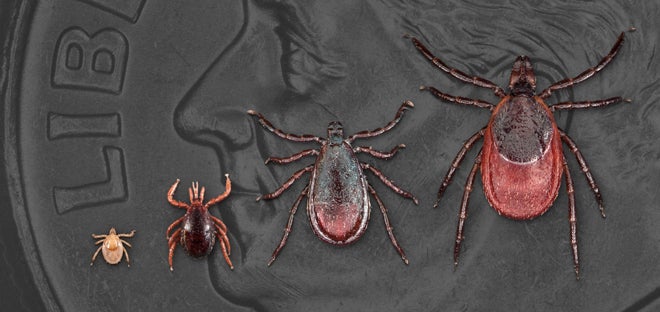Peak tick season
is heading towards the US, and experts anticipate this summer will be exceptionally harsh.
However, is it the absolute worst in history?
The University of Rhode Island entomologist Dr. Thomas “The Tick Guy” Mathers informed
The Independent
while it may be premature to conclude, the figures are cause for concern—he has seen an increase in submissions of nymphal blacklegged ticks, known carriers of Lyme disease, to the university’s facility.
TickSpotters platform
So far this month, it exceeds the weekly average for the corresponding period of the past ten years.
“I haven’t determined the answer quite yet, particularly regarding whether it signifies an upward trend—but my suspicion leans towards yes, simply due to the significant increase in nymphal blacklegged ticks I’ve observed over the last few weeks,” he clarified.
Mathers noted that
federal data
indicates that emergency room visits due to tick-related issues have increased this year, with the number of cases almost doubling from 70 in April to 131 in May.

Researchers who also tally ticks are observing a notable increase in the number of samples collected.
Professor Dr. Saravanan Thangamani from New York’s SUNY Upstate Medical University, who oversees the Upstate Tick Testing Laboratory, has cautioned that they have received an increased number of tick samples this period compared to the previous year at the same time, indicating
a 217 percent increase
.
“Given the pattern of tick submissions I’ve seen so far, I anticipate this tick season will be more severe than those in prior years,” he warned.
However, Rutgers University professor and entomologist Dina Fonseca isn’t prepared to jump to that conclusion just yet. She is involved with a submission initiative known as
New Jersey Ticks 4 Science!
She mentioned that each year, people claim it’s the worst year for ticks, pointing out the lack of standardized tick monitoring. Additionally, they’re receiving more samples than before; however, they can’t determine whether this increase is due to higher reporting rates among individuals.
Truthfully, we lack sufficient long-term data to determine whether this year is worse or better than average,” explained Fonseca. “We simply don’t know.
What dangers do ticks in the USA present?
Regardless of the situation, the increased tick activity from June to July exposes Americans to 90 different tick species along with the diseases they might transmit. While these ticks inhabit areas on both coasts, they’re
primarily located in the eastern U.S.
Certain species, such as brown dog ticks and blacklegged ticks, have a broader distribution.
Failing to prepare for ticks during outdoor activities and camping might result in a fatal situation—though this is exceedingly uncommon.
People bitten by ticks
might come into contact with the Powassan virus
Babesiosis, Anaplasmosis, Tularemia, Lyme disease, and other pathogens capable of causing human illness. Individuals may simultaneously suffer from several of these ailments.
Fonseca points out that people should truly be concerned about nymphal black-legged ticks, as these tiny pests can carry four distinct disease-causing agents. This list of diseases encompasses Lyme disease, among others.
can result in facial paralysis
and an irregular heartbeat if left unchecked.
Although
larger than larval ticks
Nymphal ticks are as small as a poppy seed. Due to their tiny size, they can be difficult to notice – this holds true even for individuals familiar with the local tick species and their habitats.
“Observe the bowtie on Abraham Lincoln’s image on a penny; it’s about the same size as an adult blacklegged tick,” Fonseca mentioned.

Exposure and prevention
While it’s easy to miss ticks, it can take about two days for any transmission to occur after a bite. People who find ticks on their skin
should take them out using tweezers
at the earliest opportunity. Individuals who experience a rash or fever following the procedure should seek medical advice from a doctor.
When it comes to preventing something, knowledge is key.
Reducing exposure
The most effective method to prevent adverse health effects, according to Mather, involves adhering to his “threeTs” guideline. This includes wearing snug garments, ensuring shirts and pant legs are tucked in, and using attire impregnated with a 0.5 percent permethrin treatment.
“If repellents aren’t used, they can be incredibly cruel,” Fonseca recalled, mentioning an instance where she removed 30 to 40 ticks from her hair. Mathers recounted a visit to Fire Island during which she encountered “hundreds” of swiftly moving ticks.
Regrettably, as the climate shifts, it presents more opportunities for picking up these parasitic hitchhikers. A warmer environment leads to increased moisture, which benefits parasites, causing them to flourish. Ticks have been noticed migrating towards northern regions, whereas southern dryness hinders their proliferation.
“One of the simplest methods to eliminate ticks is to completely dehydrate them,” stated Fonseca.
Self-reliant readers are globally conscious individuals who aren’t categorized by conventional statistics or descriptions but characterized by their perspectives. In our progressively disjointed society, groups cherish genuine data and candid viewpoints presented directly from an impartial news source they find credible. With knowledge and motivation, these independent thinkers feel enabled and prepared to advocate for what they hold dear.







